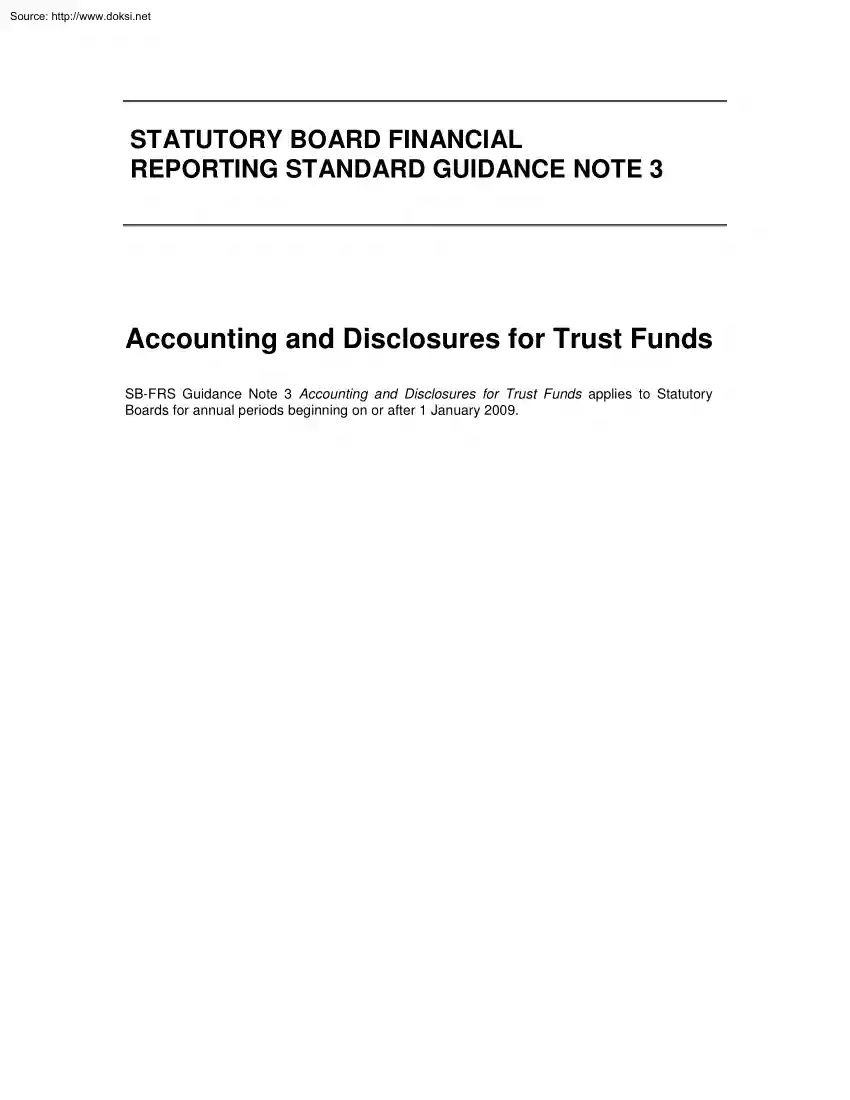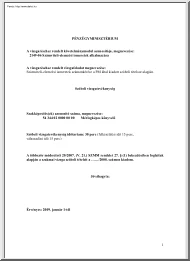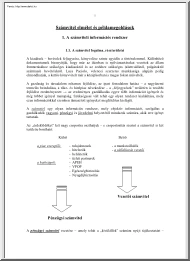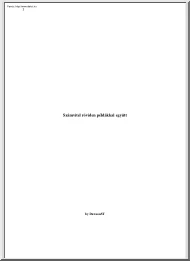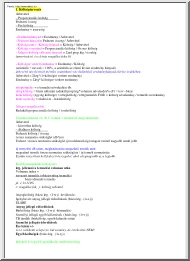Datasheet
Year, pagecount:2009, 11 page(s)
Language:English
Downloads:3
Uploaded:September 19, 2017
Size:507 KB
Institution:
-
Comments:
Attachment:-
Download in PDF:Please log in!
Comments
No comments yet. You can be the first!Most popular documents in this category
Content extract
Source: http://www.doksinet STATUTORY BOARD FINANCIAL REPORTING STANDARD GUIDANCE NOTE 3 Accounting and Disclosures for Trust Funds SB-FRS Guidance Note 3 Accounting and Disclosures for Trust Funds applies to Statutory Boards for annual periods beginning on or after 1 January 2009. Source: http://www.doksinet Contents paragraphs Statutory Board Financial Reporting Standard Guidance Note 3 Accounting and Disclosures for Trust Funds OBJECTIVE 1 SCOPE 2 ACCOUNTING AND DISCLOSURES FOR TRUST FUNDS 3 - 20 Definition 3 -5 Control over a fund 6–7 Characteristics of Trust Funds 8-13 Trust Funds and Other Funds 14-16 Accounting for Trust Funds 17-19 Disclosures for Trust Funds 20 EFFECTIVE DATE ANNEX A ANNEX B ANNEX C 21 Source: http://www.doksinet Statutory Board Financial Reporting Standard Guidance Note 3 Accounting and Disclosures for Trust Funds is set out in paragraphs 1-21. All the paragraphs have equal authority SB-FRS Guidance Notes are issued to standardise
the accounting and disclosure requirements of Statutory Boards in specific areas and are to be complied with by Statutory Boards. These Guidance Notes rank behind SB-FRS and INT SB-FRS in terms of importance. Source: http://www.doksinet Statutory Board Financial Reporting Standard Guidance Note 3 Accounting and Disclosures for Trust Funds Objective 1. This Note provides guidance on the accounting and disclosures for trust funds held by Statutory Boards (SBs). Scope 2. This Guidance Note shall be applied to all general purpose financial statements prepared and presented in accordance with Statutory Board Financial Reporting Standard (SBFRS). Accounting and Disclosures for Trust Funds Definition 3. A trust fund is defined as a fund for which a reporting SB acts as custodian, trustee, manager or agent but does not exercise control over. 4. Control as defined by SB-FRS 27 Consolidated and Separate Financial Statements (paragraph 4), is the power to govern the financial and
operating policies of an entity so as to obtain benefits from its activities. In instances where no entity retains absolute control over the financial and operating policies of the fund, the entity which has the power to govern the majority of the financial and operating policies is the controlling party. 5. In the context of SBs, benefits can extend beyond financial gains or access to additional cash or other economic resources. If a fund assists a SB in achieving its objectives, the SB is considered to have obtained benefits from the fund. In some cases, SBs earn management or agency fees from administering trust funds. Such fees or income are financial benefits earned in their roles as the agent or manager, and should not result in the SBs being considered owners of the funds. Control over a Fund 6. Certain SBs act as agents of funds that are created via contributions from their parent Ministries, or other parties. While these SBs are in charge of the day-to-day operations of
the fund, the majority of financial and operating policies are set out via a trust deed, memorandum of understanding, agreement or other documents that is not decided upon by the SB. In such instances, the SB should not be considered as exercising control over the fund as it is merely operating the fund in accordance with the financial and operating policies of the fund that have already been set out. For example, the trust deed of a fund may state when and to whom the SB can disburse amounts within the fund. The trust deed may even allow for the SB to exercise its discretion within boundaries for certain disbursements. In such an instance, although the SB operates the fund, it is not considered to be exercising control over the fund, even if it is allowed discretion for certain disbursements. 1 Source: http://www.doksinet 7. In some cases, a committee or council decides on or has the power to vary the financial and operating policies of the fund. If the SB operating the fund has
the power over more than half of the voting rights of that committee or council, or has the power to appoint or remove the majority of the members of that committee or council, then the SB is considered to be exercising control over the fund. 8. The definition of trust funds depends on the substance rather than form of the fund, legal or otherwise. In assessing whether the fund is a trust fund a SB shall consider the following characteristics: i. ii. iii. iv. v. Fund is held in trust and/or managed by the SB as an agent; The SB does not bear/enjoy the majority of the risks and rewards incidental to the activities of the fund; Fund can only be used for specified purposes determined by the Principal; The SB does not have the right to decide how the residual amounts in the fund are to be used after the closure of the fund; and The principal often has unconditional rights to remove an agent Fund is held in trust and/or managed by the SB as an agent 9. There should be a fiduciary role
played by the SB to ensure that the fund is properly accounted for and used according to the objectives of the fund. In most cases, there is a trust agreement, memorandum of understanding, legislation or other documents that governs this. However, the non-existence of such documents does not necessarily mean that a fund is not a trust fund as trust can often be implicit. In this case, the SB does not exercise control over the fund to obtain benefits from its activities (which includes assisting the SB in achieving its objectives), other than payment of agency fee mutually agreed between the parties. The SB does not bear/enjoy the majority of the risks and rewards incidental to the activities of the fund 10. The majority of the risks and rewards incidental to the activities of the fund is borne/enjoyed by the principal. Rights to the rewards and benefits of the fund’s activities may be formalised through a statute, contract, agreement, or trust deed etc. Fund can only be used for
specified purposes determined by the Principal 11. The fund must be used only for the purposes specified by the trust agreement, memorandum of understanding etc, determined by the Principal. In some cases, SBs earn management or agency fees from administering trust funds. Such fees or income are not considered as financial benefits of an owner. The SB does not have the right to decide how the residual amounts in the fund are to be used after the closure of the fund 12. Some trust funds are set up for a specified timeframe, specified project or based on a specified agreement. Upon completion of the project or termination of the agreement, the fund balance is either distributed in accordance with an agreement, deed etc, returned to contributors, or distributed as directed by a party other than the SB. The residual funds do not belong to the SB. 2 Source: http://www.doksinet The principal often has unconditional right to remove agent 13. A principal often has unconditional right
to remove an agent that is undertaking the activities on behalf of the principal. The unconditional right to remove an agent ensures that the principal maintains the power to direct the financing and operating activities of the fund. Protective rights like removal of agents in circumstances like bankruptcy or breach of contract are not unconditional rights of removal of agent. Trust Funds and Other Funds 14. Some SBs separately disclose a portion of their equity as unrestricted (general or designated) or restricted funds. Restricted and designated funds are usually received or set aside for specific purposes and there are restrictions on the ability of the SB to distribute or otherwise apply the funds. However, restricted and designated funds are distinct from trust funds in that the SB is still considered as exercising control over the funds and the funds are owned by the SB. 15. Designated funds are funds earmarked by SBs within their general funds for specific purposes. The SBs
have the power to re-designate such funds within their general funds. This is distinct from restricted funds which the SBs do not have the power to redesignate their use 16. Annex A explains via a flowchart, the differences between trust funds, designated funds and restricted funds. Please refer to Statutory Board Financial Reporting Standard Guidance Note 1 Accounting and Disclosure for Funds, Grants, Accumulated Surplus and Reserves, for the accounting and disclosure requirements for restricted funds. Accounting for Trust Funds 17. Trust funds (i.e funds that fulfill the definition in paragraph 3) should not be included in the primary statements of the SBs, i.e Statement of Financial Position, Statement of Comprehensive Income, Statement of Cash Flows and Statement of Changes in Equity. The net assets of the trust funds should instead be presented at the bottom of the Statement of Financial Position with disclosures in the notes of the financial statements of SBs in accordance
with paragraph 20. Annex C provides an illustrative example of the presentation (highlighted in yellow). 18. In most cases, SBs maintain bank accounts for the trust funds separate from the SBs’ own bank accounts. However, there may be instances where SBs place cash held on behalf of trust funds in their own bank accounts. If any cash of trust funds are maintained within the SBs’ own bank accounts, these amounts held in trust for the trust funds should be included as part of the cash and cash equivalent balances of the SBs in the Statement of Financial Position with a corresponding liability to the trust funds. Cash belonging to the trust funds should not be included as part of the SBs’ cash and cash equivalents in the Statement of Cash Flows. 19. The basis of accounting (e.g cash accounting or accrual accounting etc) for the disclosures of the trust funds in the financial statements of the reporting SB should be decided upon by the trustees of the fund, or other relevant
decision-makers of the trust funds, in consultation with the owners of the fund, if any. 3 Source: http://www.doksinet Disclosures for Trust Funds 20. The following disclosures of trust funds shall be made in the notes to the financial statements subject to the requirements of relevant legislation, if any: (i) (ii) (iii) (iv) (v) The nature of the trust funds; Statement of Comprehensive Income of the trust funds; Statement of Financial Position of the trust funds; For any cash or cash equivalents belonging to trust funds that have been included as part of the SB’s cash and cash equivalent balance, the amount of cash and cash equivalents held in trust and the trust funds which own these amounts; and Basis of accounting for the trust funds. Effective Date 21. This Guidance Note is operative for financial statements covering periods beginning on or after 1 January 2009. 4 Source: http://www.doksinet Annex A Differences between Trust, Designated and Restricted Funds Does
the fund meet the definition of a trust fund under SB-FRS Guidance Note 3? Trust Fund Y N N Is the fund designated for specific purpose? Unrestricted Fund (General Fund) Y Is the fund designated for specific purpose by the SB out of general or unrestricted fund? Y N Designated Fund (unrestricted) Restricted Fund 5 Source: http://www.doksinet Annex B Examples: Application of Definition of Trust Funds Trust Fund of SB Scenario: SB A has been appointed by Ministry B as an agent to build a series of infrastructural assets. The assets are to belong to Ministry B. SB A’s role is to engage contractors to build the assets, receive funds from Ministry B and use them to make payments to the contractors. As agreed between SB A and Ministry B, funds are to be remitted from Ministry B to SB A at most one month in advance before the payments are made to the contractors. Risks of the project such as cost escalations, reside with Ministry B, unless losses are the result of SB A’s
negligence. All interest income arising from the moneys disbursed from Ministry B have to be remitted back to Ministry B on a monthly basis. Residual amounts upon the completion of the infrastructural assets have to be returned to Ministry B. Application: Although SB A is the party holding the funds and executing the project, it is doing so as an agent. The use of the funds has been dictated by Ministry B and Ministry B is the beneficiary of the fund since the resulting infrastructural assets belong to Ministry B. As such, Ministry B is the party that controls the fund. SB A also does not bear/enjoy the majority of the risks and rewards incidental to the activities of the fund. The fund is therefore considered a trust fund of SB A Designated Fund of SB Scenario : Polytechnic Y is a SB. The Board of Polytechnic Y decides to create a $2m scholarship fund to sponsor deserving students on exchange programmes abroad. The $2m is to be funded using the accumulated surplus of Polytechnic Y.
The $2m fund is not to be used for any other purposes. The management of Polytechnic Y proposes a list of students and amounts to be sponsored, which are to be approved by the Board. Application: There are restrictions on the ability of the SB to use the $2m scholarship fund as it has been carved out of the Polytechnic Y’s accumulated surplus for a specific purpose. Control over the fund still resides within Polytechnic Y as its Board is the approving authority for the disbursement of the funds. Hence the fund is not a trust fund of the SB It is a designated fund as the funds are set aside from general funds for specific purposes. The SB has the power to re-designate the funds within unrestricted funds. 6 Source: http://www.doksinet Restricted Fund Of SB Scenario : A Fund is set up by SB as a trust to receive tax-exempt donations for specific purposes. There are restrictions on the SB in relation to the application of these funds. The trustees comprised of the chairman, chief
executive and other board members of the SB. The activities of the Fund are within the objectives of the SB. Application: There are restrictions on the use of the fund received from the public subject to a specific trust deed which is within the objectives of the SB. The SB exercise control over the fund to obtain benefits from its activities. Hence the fund is not a trust fund but a restricted fund 7 Source: http://www.doksinet Annex C Example: Presentation of Trust Funds on Statement of Financial Position Note 31 Dec 20X8 31 Dec 20X7 1 1,000,000 800,000 2 250,000 200,000 Total assets 1,250,000 1,000,000 EQUITY AND LIABILITIES Equity attributable to owners of the parent . 3 1,000,000 800,000 Total equity 1,000,000 800,000 4 200,000 150,000 5 50,000 250,000 50,000 200,000 1,250,000 1,000,000 250,000 185,000 125,000 120,000 ASSETS Non-current assets . Current assets . Non-current liabilities . Current liabilities . Total liabilities Total equity and
liabilities Net Assets of Trust Funds XXXX Trust Fund YYYY Trust Fund 6 7 8
the accounting and disclosure requirements of Statutory Boards in specific areas and are to be complied with by Statutory Boards. These Guidance Notes rank behind SB-FRS and INT SB-FRS in terms of importance. Source: http://www.doksinet Statutory Board Financial Reporting Standard Guidance Note 3 Accounting and Disclosures for Trust Funds Objective 1. This Note provides guidance on the accounting and disclosures for trust funds held by Statutory Boards (SBs). Scope 2. This Guidance Note shall be applied to all general purpose financial statements prepared and presented in accordance with Statutory Board Financial Reporting Standard (SBFRS). Accounting and Disclosures for Trust Funds Definition 3. A trust fund is defined as a fund for which a reporting SB acts as custodian, trustee, manager or agent but does not exercise control over. 4. Control as defined by SB-FRS 27 Consolidated and Separate Financial Statements (paragraph 4), is the power to govern the financial and
operating policies of an entity so as to obtain benefits from its activities. In instances where no entity retains absolute control over the financial and operating policies of the fund, the entity which has the power to govern the majority of the financial and operating policies is the controlling party. 5. In the context of SBs, benefits can extend beyond financial gains or access to additional cash or other economic resources. If a fund assists a SB in achieving its objectives, the SB is considered to have obtained benefits from the fund. In some cases, SBs earn management or agency fees from administering trust funds. Such fees or income are financial benefits earned in their roles as the agent or manager, and should not result in the SBs being considered owners of the funds. Control over a Fund 6. Certain SBs act as agents of funds that are created via contributions from their parent Ministries, or other parties. While these SBs are in charge of the day-to-day operations of
the fund, the majority of financial and operating policies are set out via a trust deed, memorandum of understanding, agreement or other documents that is not decided upon by the SB. In such instances, the SB should not be considered as exercising control over the fund as it is merely operating the fund in accordance with the financial and operating policies of the fund that have already been set out. For example, the trust deed of a fund may state when and to whom the SB can disburse amounts within the fund. The trust deed may even allow for the SB to exercise its discretion within boundaries for certain disbursements. In such an instance, although the SB operates the fund, it is not considered to be exercising control over the fund, even if it is allowed discretion for certain disbursements. 1 Source: http://www.doksinet 7. In some cases, a committee or council decides on or has the power to vary the financial and operating policies of the fund. If the SB operating the fund has
the power over more than half of the voting rights of that committee or council, or has the power to appoint or remove the majority of the members of that committee or council, then the SB is considered to be exercising control over the fund. 8. The definition of trust funds depends on the substance rather than form of the fund, legal or otherwise. In assessing whether the fund is a trust fund a SB shall consider the following characteristics: i. ii. iii. iv. v. Fund is held in trust and/or managed by the SB as an agent; The SB does not bear/enjoy the majority of the risks and rewards incidental to the activities of the fund; Fund can only be used for specified purposes determined by the Principal; The SB does not have the right to decide how the residual amounts in the fund are to be used after the closure of the fund; and The principal often has unconditional rights to remove an agent Fund is held in trust and/or managed by the SB as an agent 9. There should be a fiduciary role
played by the SB to ensure that the fund is properly accounted for and used according to the objectives of the fund. In most cases, there is a trust agreement, memorandum of understanding, legislation or other documents that governs this. However, the non-existence of such documents does not necessarily mean that a fund is not a trust fund as trust can often be implicit. In this case, the SB does not exercise control over the fund to obtain benefits from its activities (which includes assisting the SB in achieving its objectives), other than payment of agency fee mutually agreed between the parties. The SB does not bear/enjoy the majority of the risks and rewards incidental to the activities of the fund 10. The majority of the risks and rewards incidental to the activities of the fund is borne/enjoyed by the principal. Rights to the rewards and benefits of the fund’s activities may be formalised through a statute, contract, agreement, or trust deed etc. Fund can only be used for
specified purposes determined by the Principal 11. The fund must be used only for the purposes specified by the trust agreement, memorandum of understanding etc, determined by the Principal. In some cases, SBs earn management or agency fees from administering trust funds. Such fees or income are not considered as financial benefits of an owner. The SB does not have the right to decide how the residual amounts in the fund are to be used after the closure of the fund 12. Some trust funds are set up for a specified timeframe, specified project or based on a specified agreement. Upon completion of the project or termination of the agreement, the fund balance is either distributed in accordance with an agreement, deed etc, returned to contributors, or distributed as directed by a party other than the SB. The residual funds do not belong to the SB. 2 Source: http://www.doksinet The principal often has unconditional right to remove agent 13. A principal often has unconditional right
to remove an agent that is undertaking the activities on behalf of the principal. The unconditional right to remove an agent ensures that the principal maintains the power to direct the financing and operating activities of the fund. Protective rights like removal of agents in circumstances like bankruptcy or breach of contract are not unconditional rights of removal of agent. Trust Funds and Other Funds 14. Some SBs separately disclose a portion of their equity as unrestricted (general or designated) or restricted funds. Restricted and designated funds are usually received or set aside for specific purposes and there are restrictions on the ability of the SB to distribute or otherwise apply the funds. However, restricted and designated funds are distinct from trust funds in that the SB is still considered as exercising control over the funds and the funds are owned by the SB. 15. Designated funds are funds earmarked by SBs within their general funds for specific purposes. The SBs
have the power to re-designate such funds within their general funds. This is distinct from restricted funds which the SBs do not have the power to redesignate their use 16. Annex A explains via a flowchart, the differences between trust funds, designated funds and restricted funds. Please refer to Statutory Board Financial Reporting Standard Guidance Note 1 Accounting and Disclosure for Funds, Grants, Accumulated Surplus and Reserves, for the accounting and disclosure requirements for restricted funds. Accounting for Trust Funds 17. Trust funds (i.e funds that fulfill the definition in paragraph 3) should not be included in the primary statements of the SBs, i.e Statement of Financial Position, Statement of Comprehensive Income, Statement of Cash Flows and Statement of Changes in Equity. The net assets of the trust funds should instead be presented at the bottom of the Statement of Financial Position with disclosures in the notes of the financial statements of SBs in accordance
with paragraph 20. Annex C provides an illustrative example of the presentation (highlighted in yellow). 18. In most cases, SBs maintain bank accounts for the trust funds separate from the SBs’ own bank accounts. However, there may be instances where SBs place cash held on behalf of trust funds in their own bank accounts. If any cash of trust funds are maintained within the SBs’ own bank accounts, these amounts held in trust for the trust funds should be included as part of the cash and cash equivalent balances of the SBs in the Statement of Financial Position with a corresponding liability to the trust funds. Cash belonging to the trust funds should not be included as part of the SBs’ cash and cash equivalents in the Statement of Cash Flows. 19. The basis of accounting (e.g cash accounting or accrual accounting etc) for the disclosures of the trust funds in the financial statements of the reporting SB should be decided upon by the trustees of the fund, or other relevant
decision-makers of the trust funds, in consultation with the owners of the fund, if any. 3 Source: http://www.doksinet Disclosures for Trust Funds 20. The following disclosures of trust funds shall be made in the notes to the financial statements subject to the requirements of relevant legislation, if any: (i) (ii) (iii) (iv) (v) The nature of the trust funds; Statement of Comprehensive Income of the trust funds; Statement of Financial Position of the trust funds; For any cash or cash equivalents belonging to trust funds that have been included as part of the SB’s cash and cash equivalent balance, the amount of cash and cash equivalents held in trust and the trust funds which own these amounts; and Basis of accounting for the trust funds. Effective Date 21. This Guidance Note is operative for financial statements covering periods beginning on or after 1 January 2009. 4 Source: http://www.doksinet Annex A Differences between Trust, Designated and Restricted Funds Does
the fund meet the definition of a trust fund under SB-FRS Guidance Note 3? Trust Fund Y N N Is the fund designated for specific purpose? Unrestricted Fund (General Fund) Y Is the fund designated for specific purpose by the SB out of general or unrestricted fund? Y N Designated Fund (unrestricted) Restricted Fund 5 Source: http://www.doksinet Annex B Examples: Application of Definition of Trust Funds Trust Fund of SB Scenario: SB A has been appointed by Ministry B as an agent to build a series of infrastructural assets. The assets are to belong to Ministry B. SB A’s role is to engage contractors to build the assets, receive funds from Ministry B and use them to make payments to the contractors. As agreed between SB A and Ministry B, funds are to be remitted from Ministry B to SB A at most one month in advance before the payments are made to the contractors. Risks of the project such as cost escalations, reside with Ministry B, unless losses are the result of SB A’s
negligence. All interest income arising from the moneys disbursed from Ministry B have to be remitted back to Ministry B on a monthly basis. Residual amounts upon the completion of the infrastructural assets have to be returned to Ministry B. Application: Although SB A is the party holding the funds and executing the project, it is doing so as an agent. The use of the funds has been dictated by Ministry B and Ministry B is the beneficiary of the fund since the resulting infrastructural assets belong to Ministry B. As such, Ministry B is the party that controls the fund. SB A also does not bear/enjoy the majority of the risks and rewards incidental to the activities of the fund. The fund is therefore considered a trust fund of SB A Designated Fund of SB Scenario : Polytechnic Y is a SB. The Board of Polytechnic Y decides to create a $2m scholarship fund to sponsor deserving students on exchange programmes abroad. The $2m is to be funded using the accumulated surplus of Polytechnic Y.
The $2m fund is not to be used for any other purposes. The management of Polytechnic Y proposes a list of students and amounts to be sponsored, which are to be approved by the Board. Application: There are restrictions on the ability of the SB to use the $2m scholarship fund as it has been carved out of the Polytechnic Y’s accumulated surplus for a specific purpose. Control over the fund still resides within Polytechnic Y as its Board is the approving authority for the disbursement of the funds. Hence the fund is not a trust fund of the SB It is a designated fund as the funds are set aside from general funds for specific purposes. The SB has the power to re-designate the funds within unrestricted funds. 6 Source: http://www.doksinet Restricted Fund Of SB Scenario : A Fund is set up by SB as a trust to receive tax-exempt donations for specific purposes. There are restrictions on the SB in relation to the application of these funds. The trustees comprised of the chairman, chief
executive and other board members of the SB. The activities of the Fund are within the objectives of the SB. Application: There are restrictions on the use of the fund received from the public subject to a specific trust deed which is within the objectives of the SB. The SB exercise control over the fund to obtain benefits from its activities. Hence the fund is not a trust fund but a restricted fund 7 Source: http://www.doksinet Annex C Example: Presentation of Trust Funds on Statement of Financial Position Note 31 Dec 20X8 31 Dec 20X7 1 1,000,000 800,000 2 250,000 200,000 Total assets 1,250,000 1,000,000 EQUITY AND LIABILITIES Equity attributable to owners of the parent . 3 1,000,000 800,000 Total equity 1,000,000 800,000 4 200,000 150,000 5 50,000 250,000 50,000 200,000 1,250,000 1,000,000 250,000 185,000 125,000 120,000 ASSETS Non-current assets . Current assets . Non-current liabilities . Current liabilities . Total liabilities Total equity and
liabilities Net Assets of Trust Funds XXXX Trust Fund YYYY Trust Fund 6 7 8
